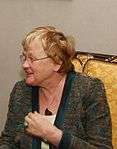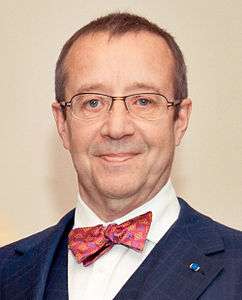2006 Estonian presidential election
Estonian presidential elections, 2006 took place over four rounds, which were held on 28 and 29 August,[1] and 23 September 2006.[2] The first three rounds of the presidential election were held within the Riigikogu, which is Estonia's Parliament, as specified under electoral law. The two top candidates, Ene Ergma and Toomas Hendrik Ilves, were not elected because they did not obtain the required two-thirds of the votes in the Riigikogu.
| |||||||||||||
| |||||||||||||
| |||||||||||||
As the Riigikogu was unable to make a decision within the first three rounds, it was required under Estonian electoral law to convene an Electoral Body to decide the presidency. It was convened on 23 September, and Toomas Hendrik Ilves emerged as the winner over the other candidate and incumbent president, Arnold Rüütel, after obtaining a majority of the votes in the Electoral Body.[3]
Electoral System
The President of the Republic of Estonia is indirectly elected, and serves primarily to represent the country as the symbolic Head of State of the executive branch.[4] The president is elected for a five-year term and cannot stand for more than two consecutive terms. Any Estonian citizen by birth over the age of forty can be nominated as a candidate, but must be supported by a minimum of one fifth of the Riigikogu, equivalent to 21 members.[5]
The President of the Republic Election Act, which was passed on April 10, 1996, governs the election process. There are up to five rounds of elections. In the first round, members of the Riigikogu vote for the new president; a candidate receiving a two-thirds majority of votes is elected. If no candidate receives the required majority, a second round of voting is held the next day. If no candidate receives the required majority during the second round, a third round of voting is held on the same day in which the two candidates who earned the most votes in the second round compete for a two-thirds majority.
If neither candidate receives the required majority during the third round, the President of the Riigikogu convenes an electoral body composed of the members of the Riigikogu as well as representatives from local government councils to choose the new president. Each local government council elects their own representatives, and the number of representatives from each community depends on population.[6] In the 2006 election, the electoral body contained 347 people: 101 Riigikogu members and 247 local representatives.[7] In the fourth round, candidates who participated in the third round of voting, or newly nominated candidates with the support of at least 21 members of the electoral body are entered on the ballot. The electoral body votes, and the candidate receiving a majority of votes is elected. If no candidate receives a majority, a fifth round of voting is held on the same day. The two candidates who received the most votes during the fourth round are entered into the fifth round, and the candidate receiving a majority of votes is elected.[8]
Main Candidates
| Candidates | ||||
|---|---|---|---|---|
Ene Ergma Chairman of Pro Patria and Res Publica Union |
Toomas Hendrik Ilves Fourth President of Estonia and Chairman of Social Democratic Party (Estonia) |
Arnold Rüütel Former President of Estonia and Chairman of Conservative People's Party of Estonia | ||
Other Candidates
| Laine Janes
(Reform Party of Estonia) |
Liina Tonisson
(Independent) |
Peeter Tulviste | Jaan Mannik | Toomas Varek
(Centre Party of Estonia) |
Aadu Must
(Centre Party of Estonia) |
Paul-Eerik Rummo
(Reform Party) |
Enn Eesma
(Centre Party of Estonia) |
Jaak Aaviksoo
(Res Publica) |
Jaak Manitski |
The Electoral Campaign
In March 2006 five of the six political parties in the Riigikogu appointed twelve potential candidates for the Parliament's election of the President of the Republic. On 11 May Laine Janes, Liina Tonisson, Peeter Tulviste, Jaan Mannik, and Toomas Varek were eliminated from the race. On 28 June Aadu Must, Paul-Erik Rummo, and Enn Eesma were eliminated. Finally, Jaak Aavisko was eliminated on 19 July, leaving two main candidates: Toomas Hendrik Ilves, who is a member of the Social Democrat Party, a former Ambassador of the United States, and a Minister of Foreign Affairs, and Ene Ergma, a former Minister and Deputy Parliamentary Speaker.[10] Neither Ilves nor Ergma got the necessary two-thirds of the vote to become the president during the parliamentary rounds of voting on August 28 and 29.[11]
On 18 May the present president of Estonia Arnold Rüütel declared that he would be a candidate for re-election if the vote was decided by the electoral college, which occurs when the Parliament fails to elect a President with a two-third majority. Though, according to analysts, Rüütel had high chances in the electoral college and was supported by the People's Union and the Centre Party, he was constantly criticized for not having participated in the Riigikogu round and not taking part in debates. Rüütel held a poor command of the English language and was often criticised for his passive role in foreign affairs.[12] He was mostly supported by the Russian-speaking population, older voters, the least educated and by those living in the country's rural zones. The end of his term was overshadowed by a scandalous story shown on the Estonian Television about Rüütel's teenage granddaughters running orgies in the presidential palace. Consequently, younger generation perceived their president as weak and incompetent and showed preference for Toomas Ilves, who was nominated as a candidate for the 2006 presidential election by the Reform Party, Union of Pro Patria and Res Publica, and his own Social Democratic party.
His victory in the 2006 presidential election, that was named “clash of the eras”, was regarded partially as a protest against the parties that supported Rüüteland and as a rejection of the Soviet-era leader in favor of youthful and more liberal president.[13] As Toomas Hendrik Ilves was the sole candidate in the third round of voting, he automatically qualified for a place in the fourth round of voting conducted with the Electoral Body. On the 21st of September, Arnold Rüütel was nominated by at least 21 members of the Electoral Body to participate in the fourth round of voting.[14] On the 23rd of September, 174 out of the 345 available votes were polled for Toomas Hendrik Ilves for the position of the President of the Republic of Estonia. As he obtained the majority (by a sliver; less 2 votes and it would have led to run-off) of the votes, he was elected as the President of Estonia.[15]
The Election
The first three rounds of the presidential election were held in the Estonian parliament between Toomas Hendrik Ilves and Ene Ergma. The first parliamentary round was held on August 26, 2006 with Ene Ergma receiving 65 of 101 votes. On August 29, 2006, Toomas Hendrik Ilves gained 64 votes in the second round held in the parliament. That same day, Ilves gained 64 votes again in the third round. The Centre Party, which would later support Rütel, and the People's Union party refused to vote in the third round.[16] These first three rounds of voting were inconclusive, since neither candidate obtained the needed ⅔ of the 101 votes to secure the presidency.[17] However, since Ilves was the only remaining candidate by the third round, he continued onward to the final round determined by the electoral body. At this point, Arnold Rütel, president at the time, stepped in to compete in the fourth round as well.[18] This final round was a simple majority vote within the electoral college, which consists of 347 members from both parliament and local governments [19] This round was held on September 23, 2006, and Ilves won with 174 votes to Rütel's 162. 173 votes were needed to win the presidency. Toomas Hendrik Ilves entered the presidential office on October 9, 2006.[20]
Results
| Candidate | First round | Second round | Third round | Fourth round | ||||
|---|---|---|---|---|---|---|---|---|
| Votes | % | Votes | % | Votes | % | Votes | % | |
| Ene Ergma | 65 | 64.36 | – | – | – | – | – | – |
| Toomas Hendrik Ilves | – | – | 64 | 63.37 | 64 | 63.37 | 174 | 50.43 |
| Arnold Rüütel | – | – | – | – | – | – | 162 | 46.96 |
| Abstentions | 36 | 35.64 | 36 | 35.64 | 36 | 35.64 | – | – |
| Invalid/blank votes | – | – | 1 | 0.99 | 1 | 0.99 | 9 | 2.61 |
| Total | 101 | 100 | 101 | 100 | 101 | 100 | 345 | 100 |
| Source: Vabariigi Valimiskomisjon | ||||||||
References
- "President of the Republic of Estonia Elections." Valimised
- "President of the Republic of Estonia Elections." Valimised
- "Elections of the President of the Republic of Estonia 2016." Valimised.
- Dubrovnik, Tadej, "The Position, Election and Powers of the President of the Republic of Estonia"
- Corinne Deloy and Rodolphe Laffranque, "Presidential Election in Estonia, 28th August 2006"
- "The President of the Republic Election Act" (1996)
- Corinne Deloy and Rodolphe Laffranque, "Presidential Election in Estonia, 28th August 2006"
- "The President of the Republic Election Act" (1996)
- Corinne Deloy and Rodolphe Laffranque, "Presidential Election in Estonia, 28th August 2006"
- Corinne Deloy and Rodolphe Laffranque, "Presidential Election in Estonia, 28th August 2006"
- "Estonia- Politics." Global Security
- Mcnamara, Eoin Micheál " Estonia's Next President Must Give Top Priority to Foreign Affairs"
- "Estonia 2007." Freedom House
- "Elections of the President of the Republic of Estonia 2016." Valimised.
- "Elections of the President of the Republic of Estonia 2016." Valimised.
- "Estonia 2007." Freedom House
- "President of the Republic of Estonia Elections." Valimised
- Corinne Deloy and Rodolphe Laffranque, "Presidential Election in Estonia, 28th August 2006"
- "Estonia 2007." Freedom House
- National Electoral Committee, "Elections in Estonia 1992–2015"


